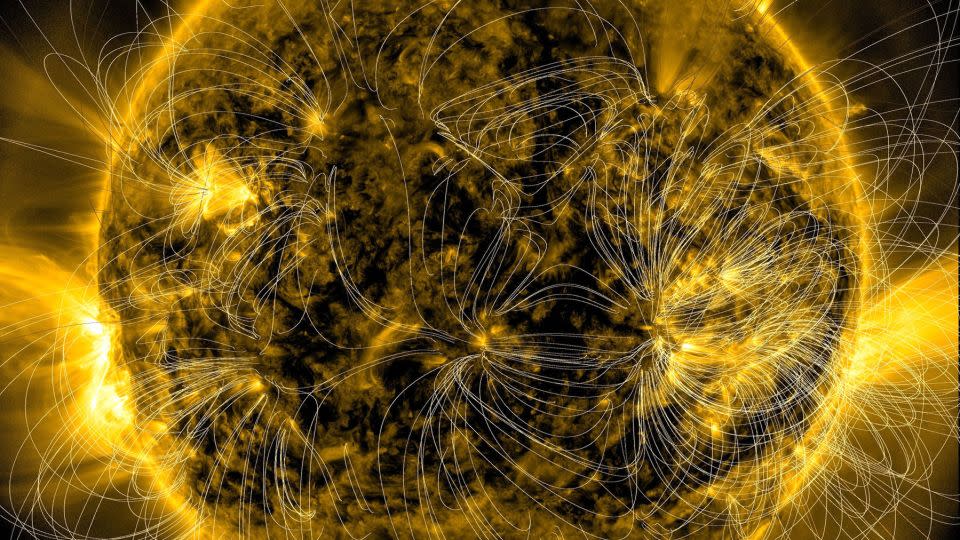Editor’s note: A version of this story appeared in CNN’s Wonder Theory newsletter. To receive it in your inbox, Sign up for free here.
I was lucky enough to catch one incredible glimpse of the northern lights from my own home this month, when the biggest solar storm to hit Earth in two decades made the auroras visible in much more southern latitudes than usual.
Despite living in the bright streets of central London, my smartphone camera captured a green haze and a pulsing sheet of purple and pink light. Capturing the moment was an unforgettable experience and one that I thought would involve expensive trips to the far north of our planet.
The storms that create spectacular auroras like the ones I witnessed originate from the Sun’s dynamic magnetic field, an astrophysical enigma that scientists this week came closer to unraveling.
Solar update

Figuring out how the Sun’s magnetic field works will help scientists improve predictions of space weather, which dazzles night sky observers but can disrupt GPS and communications satellites.
The Sun’s circular magnetic field lines, which form a tangled web of structures more complex than those on Earth, are difficult to study directly. To understand what is happening, scientists create mathematical models.
A new model, which took more than a decade to develop and required a NASA supercomputer to perform the detailed calculations, has found that the Sun’s magnetic field is generated much closer to the surface than previously thought.
The team believes their model is more accurate because is responsible for a unique solar characteristic.
A long time ago
A single gold earring found in the ruins of a 2,000-year-old building in the Pyrenees is a clue to how a devastating fire may have started. The inferno consumed the wooden structure, located in an Iron Age village called Tossal de Baltarga, and killed six animals confined in a stable.
Archaeologists believe the fire was deliberate. Had it been accidental, the building’s owners would likely have released the cattle and returned after the fire was out to retrieve the hidden gold, which was hidden in a jar.
The arsonists may have been an invading army commanded by Hannibal, the Carthaginian general who led troops against the Roman Republic, according to the new study.
The fate of the people who used the building is unknown, but the excavation uncovered revealing details of the lives from an Iberian people called Cerretani.
Sky clock


Stonehenge’s builders placed the enormous stones that make up the prehistoric monument aligned with the sunrise and sunset on the longest and shortest days of the year, revealing an intimate understanding of the sun that is still palpable today.
But does the 4,500-year-old archaeological site in southwest England – and potentially other megalithic monuments around the world – also align with the moon?
The idea that Stonehenge has a lunar connection first gained ground in the 1960s. However, the concept had not been explored systematically – until now.
This summer, archaeologists are using lunar standstilla little-known phenomenon that happens every 18.6 years, to investigate.
All over the universe
Space scientists have observed the edge of a black hole for the first time – an area known as the “dip region”.
Andrew Mummery, lead author of a new study on black holes and a researcher at the University of Oxford, compared it to the “edge of a waterfall” at the end of a river, where material orbiting nearby stars falls into the abyss.
In the diving region, matter can no longer remain in orbit and is instead thrown into the black hole. But unlike the event horizon or black hole surface, light can still escape at this point.
The findings of the study, that Albert Einstein predictedcould help astronomers better understand the formation and evolution of black holes.
wild kingdom


Corvids – the group of birds that includes crows, ravens and jays – are famously intelligent. One species of corvid may even be capable of something researchers call “mental time travel.”
This type of remembering allows the mind to recall seemingly unimportant information that you have not consciously committed to memory – for example, remembering what you had for lunch yesterday.
Researchers working with Eurasian jays trained to find food hidden under teacups say the birds may be capable of performing the feat of memory.
In the experiment, which involved decorated cups, the jays were able to remember what a specific cup tasted likeeven after the glasses were rearranged and with a delay.
And in other corvid news, crows can count up to fourdiscovered the latest research.
Explorations
Immerse yourself in these mind-expanding stories.
— Thomas Midgley Jr. was a talented American inventor who left a lasting mark on history. However, your ingenious solutions created even bigger problems.
– Microplastics were found in human testicleshighlighting the urgent need for more research to understand the role that plastics may play in promoting infertility.
— An Austrian winemaker discovered hundreds of mammoth bones in his cellar, a discovery that an expert labeled an “archaeological sensation”.
Don’t go yet: NASA has announced the latest on the long-delayed Boeing Starliner manned mission.
Did you like what you read? Oh, but there’s more. Sign here to get the next issue of Wonder Theory delivered to your inbox, brought to you by CNN Space and Science writers Ashley Strickland It is Katie Hunt. They find wonders on planets beyond our solar system and in discoveries from the ancient world.
For more news and newsletters from CNN, create an account at CNN.com



































